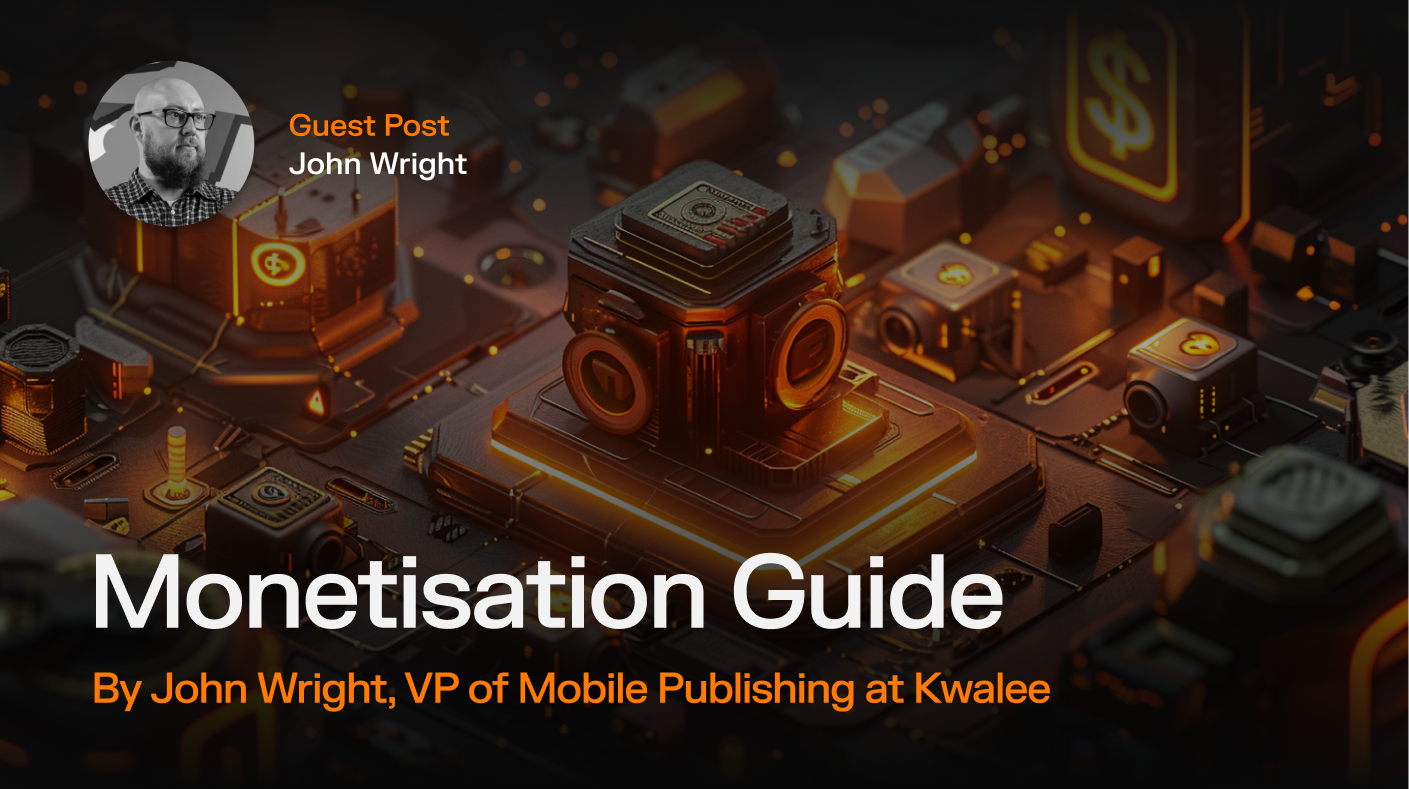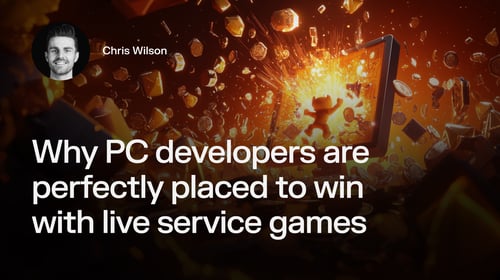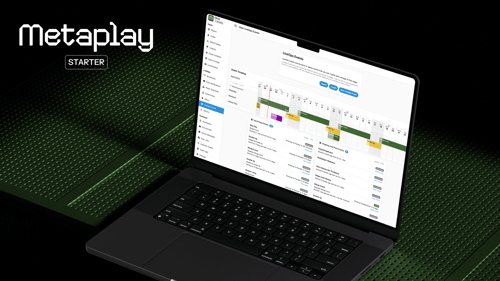
Monetisation Guide by John Wright, VP of Mobile Publishing at Kwalee

John Wright •
In-game monetisation is a cornerstone of the mobile games ecosystem, vital for sustaining and growing the industry. In this guide, Kwalee's VP of Mobile Publishing, John Wright, delves into the essentials of mobile game monetisation, focusing on the dominant Free to Play model. By covering key strategies such as ad integration, in-app purchases, player segmentation, and Live Operations, it provides developers with the foundational knowledge needed to effectively balance revenue generation with user retention and engagement.
Part 1: The Basics
Monetisation for mobile games can be easily broken down into two main categories: Free to Play and Premium.
Very simply, Free to Play allows you to download games for free to your device but has “micro-transactions” or advertisements which allow developers to make money after the fact, whereas, Premium you pay an upfront fee to play the game. Traditionally this was a one-time fee which allowed you to play the game without subsequent transactions. However that has changed over the last few years.
Free to Play is 99% of the industry, so I’ll stick to that for now.
When we talk about Free to Play, we talk about various different types of monetisation and strategy:
Monetisation Types and Strategies
Rewarded Video
Probably the most common ad unit in our industry. As a developer you have to think carefully about where to integrate this to get the desired effect. Understanding user motivations is key to monetisation, and this is no more true than with RV. This simply means placing the RV in the desired spot with a good enough reason for users to engage with it. Users then get a reward for watching a video or have some kind of multiplier applied (e.g. x2 a reward).
Interstitial
Depending on the genre of game, you will probably see a lot of these or none at all. It is what we refer to as a system-initiated ad unit rather than RV, which is user-initiated. That essentially means that there is a logic set up by the developer to serve X number of ads in a given time frame, normally referred to as “Ad frequency”, so they will show 5 ads to 1 user in 60 minutes at select break points (end of the level, for example).
Banner
A small banner or static image that is normally displayed at the bottom of the home screen.
Offer Wall
One of the traditional forms of monetisation in F2P games, essentially a micro-economic store that gives you rewards based on completing actions in other games, normally referred to as “Cost per engagement” campaigns.
In-App-Purchase
IAPs are the most premium, desired, and hardest type of monetisation to implement effectively. Ensuring you develop your game with economy in mind and that users have the right motivations to spend hard cash is no easy feat. A good casual game would normally optimise towards 4-6% of paying users, meaning 1 in 20 people that play your game end up spending money in the game.
Subscription
Essentially “subscribing” to a weekly or monthly IAP which gives you unique in-game content, bonus items or additional perks and multipliers on currency or rewards. The most profitable form of monetisation you can get.
Cross-Promotion
Probably one of the most underutilised monetisation strategies you can do today. For those who have big game portfolios or “back catalogues”, this is a simple way of getting users from one of your games to another. The idea is that if you can time it correctly at the churn point, you can potentially double your users’ overall LTV by keeping them in your ecosystem.

Part 2: Game Economy and In-App-Purchases
In-app purchases, on face value sound simple. Oh, wait. We only have to create a shop and some kind of currency conversion system? No problem. 100 gems for 99c? 200 for $1.99 sounds about right? Wrong. In my opinion, balancing game economies and cultivating player motivations to convert to spending hard cash is the most difficult thing in our industry.
Balancing Player Motivation
Let’s talk about player motivations for a minute. One of the most basic forms of this is difficulty balancing within the game and ensuring that the progression system increases difficulty at the right moments, this is what I call the Goldielocks problem. Equally important is to say that this is different for every game genre, and arguably for every game. This is why it’s important to ensure that once your game has passed the MVP stage and the core loop has been correctly developed, you start to look at user churn while A/B testing difficulty. We have found in some games, that making it harder improves the two most important metrics for us: Long-term Retention (LTR) and Percentage of Paying Players (PPP).
Equally important is how the difficulty increases over time. If you make it too hard too early, players churn. And if you make it too hard too late, players also churn.
Having a product analyst or game economist managing these tests over months of development is vital to success. Equally important is ensuring that you have correctly implemented enough metagame to keep the players interested and engaged outside of the core loop.
So while your PA/GE are working on improving the core loop, your game designers should be focusing on that metagame. Again, this comes back to player motivations and giving people multiple reasons to come back to engage with your game. This could be from secondary game mechanics, mini-games, additional progression systems, limited-time events, special items or just the basic leaderboards.
The last point what I would like to mention is community, or the motivation behind PvP or the “competition effect.” This is another one that is hard to implement and design but yields super impressive results when done correctly. Equally PvE which mimics the feeling of beating another person (or AI in this case), gives the player that feeling of accomplishment. Because of the complexity of developing such a feature, especially around game matching and servers, I would normally say that this should be done after the monetisation tests have been completed and you know this game is going to launch. Otherwise you could spend a lot of money for nothing (the outlier would be if you’re Supercell or a comparable studio who knows this is a core part of the game to begin with).
Part 3: Personas and Country Specifics
What exactly are player personas? For me, it’s the definition of a particular type of player or a bucket of users that are categorised under said “persona” which a studio then optimises a particular strategy towards.
The basic form of this was a group of high-value spenders referred to as “whales,” which for years was what everyone spoke about. Pre-Hyper Casual, there was a strategy of finding and growing the number of whales you had in your game. Effectively, those top 1% of players were how many games were successful, and without them, many games died.
So let’s break this down a bit. Firstly, you had your most valuable users, which were payers, those who did IAPs. These could be categorised as “Minnows”, “Dolphins” and “Whales”. Studios had other categories including “Killer Whales”, “Orca’s” (I even heard of “Salmon” once). The categorisation is really dependent on the studio, but let’s say it was as follows for lifetime spend:

On top of the above, you have some equally basic ones which are Event Players, Offer Takers and Non-Payers.
These four personas also have sub-types like the example above for payers. They, however, are completely defined by the data you have gathered over multiple game launches. If you’re a new studio, however, I think the four I mentioned above are the best to start with.
Once you’ve defined your player types, you should optimise your in-game strategy to maximise each one, equally trying to convert less valuable personas into more valuable ones, such as non-payers to payers, for example.
There are two main options for doing this: one, you can develop your own back-office solution that defines and categorises said users, then serve them different in-game experiences to try and maximise user potential, or you can simply pay for a third-party solution. If I were a new studio, I would probably do the latter while establishing my own over time.
Monetisation Strategies for Different Markets
Where things get more interesting, however, is looking at country specifics. So what do I mean by this? Well, as we know, players in T1 countries are more valuable to studios because they have more disposable income to spend on things like IAPs. In T3 countries payers are more scarce. So what do we do here? Just focus on T1 and forget the billions of potential players in these markets? No. We simply change the strategy depending on the market.
So, in T1, we would focus more on increasing our percentage of paying players, where the experience would be optimised towards balancing IAPs, subscriptions, providing discounts and offers and then rewarded video as the combination of IAP and RV we know is a successful one. Then for T3, we would more than likely “squeeze the lemon.” This would be adding additional ways to make money from non-payers. This is notably interstitial and optimising ad frequency, RV, and perhaps offer wall depending on the genre of your game.
Again, this has to be thoroughly tested over multiple months to find the most optimal setup for not only your user personas but also for each country tier (and eventually each country).
Part 4: Live Ops and Events
What's the best way to make more money as a studio when launching new games has never been more difficult? Live ops, and limited-timed events linked to a particular occasion, calendar or one-off special are definitely something that you need to focus on.
Let’s start with the basics. What should you really be focusing on as part of Live Operations? Events are definitely a big part of it, but let’s save that for the end (equally, I’m not going to be able to cover everything, so I will stick to these five things plus Events).
Content Updates
Just because you’ve launched your game doesn’t mean your work is done. It’s important to continue to provide content updates and changes to improve the game’s performance over time. We do not build games to be flashes in the pan; we build games that we want to have around for years to come. Reviewing your FTUE, adding more characters, levels, new features, and metagame, all of these should be factored into your product roadmap and be worked on from sprint to sprint.
Community Management
Something that I’m seeing more and more in Casual games comes from years of success in midcore, strategy and ultimately PCC games. This is the importance of establishing a community in your games, as well as outside them. Adding moderator-supported guilds and communications in game can definitely help your goals of keeping players interested and engaged over time. Equally setting up a Discord server and giving a safe place for players to discuss the game and make meaningful contributions is growing ever more important.
Personalisation
This was covered pretty much in earlier in the post, but again, the importance of personalising each user's journey based on the type of player they are is part and parcel of LiveOps.
Limited-time IAPs and subscriptions
So this can be executed in a few ways. The most basic would be discounted IAPs to payers who haven’t purchased something within a fixed period of time. Equally, there could be limited-timed IAPs or Subs that allow you to have unique or limited-time items/characters/vanity items. Finally, you could expand this further by doing an integration event with an IP holder, creating a transmedia strategy! Barbie in Stumble Guys is a great example.
Push notifications and re-engagement
Ensuring that you have a variety of push notification types, including rewards, is definitely a way to get users to re-engage, and one that is underutilised in my professional opinion. Re-engaging users is a surefire way to improve LTV if the user has churned, effectively the LTV is at 100% at that point. If you do manage to claw them back and even get them to watch a single interstitial ad, this will increase that LTV by the revenue attributed of that ad.
Lastly, Events are the most simple and easy to implement. Stick to the basics. Sit down and have an ideation session with your team. Write down all the usual cultural events like Christmas, Thanksgiving, NYE, LNY, etc., then pepper in unique events that are linked to your studio or games (like a one-year anniversary). Then you can think about more complex ones like crossovers and IP integrations.
Part 5: The Summary
We normally talk about “monetisation” as if it’s all to do with the mediations we use or the networks that generate the ads for us. In fact, monetisation, and especially the economy of games, are much more important if implemented correctly.
Monetisation isn’t easy; it’s f*cking hard, and vast. There are so many different levers to pull to make this work, and if you pull the wrong levers, your game will never find profitability and it will never scale.
Apart from the pure development of your games, nothing is more important than this exact subject.
I’ve summarised the most important points for you all here:

While I didn’t cover everything, and I intentionally didn’t dive deeply into AdMonetisation integration, mediation networks, the networks that drive it, or topics like hybrid waterfalls or bidders - since I’ve discussed those extensively in the past - I hope the content I provided was more valuable and insightful than the usual discussions about “monetisation.”
John Wright has over 11 years of experience in the AdTech/Gaming industry. As the Vice President of Mobile Publishing at Kwalee, he leads the strategy and operations for their global portfolio games, working closely with internal and external developers, partners, and platforms. He has worked with some of the biggest names in gaming, such as Activision, Zynga, Rovio, Ubisoft, FunPlus, and Outfit 7, helping them grow their user base, monetize their apps, and optimize their performance.



